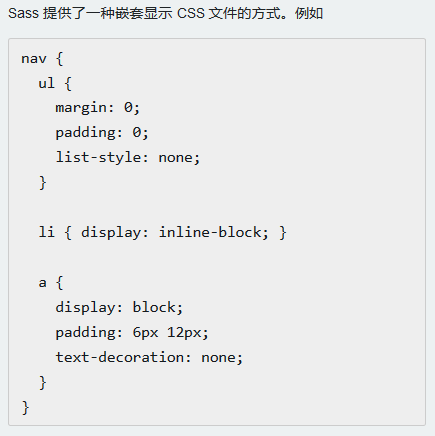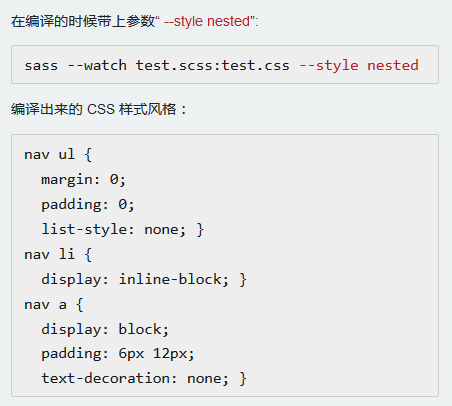Notes on getting started with sass (1)
I am a novice myself, and the notes I took down while learning Sass may be a bit wordy, but when reviewed, it is still relatively comprehensive and intuitive. Of course, the most important thing is to practice and practice to get the truth
Other CSS preprocessor languages:
CSS preprocessor technology has been very mature, and many different CSS preprocessor languages have emerged, such as:
- Sass(SCSS)
- LESS
- Stylus
- Turbine
- Swithch CSS
- CSS Cacheer
- DT CSS
Sass is the earliest CSS preprocessing language and has more powerful functions than LESS. Although Sass appeared earliest, it is far less popular than LESS.
The original indented old version syntax was not accepted by the public. Due to its powerful functions and the strong promotion of Ruby on Rails, many developers still chose Sass.
Sass is a CSS preprocessing language written in Ruby. It was originally designed to cooperate with HAML (about haml: http://www.bianceng.cn/web/Html/201411/46562_2.htm
It is designed as an indented HTML precompiler), so it has the same indentation style as HTML.
What is the difference between Sass and SCSS?
Sass and SCSS are actually the same thing. We usually call it Sass. The differences between the two are as follows:
- The file extensions are different. Sass has the “.sass” suffix as the extension, while SCSS has the “.scss” suffix as the extension
- The grammar writing method is different. Sass is written with strict indentation grammar rules, without braces ({}) and semicolons (;)
- The syntax of SCSS is very similar to our CSS syntax (There is no difference between SCSS and CSS). To put it simply, just modify your existing ".css" file directly into ".scss" and you can use it.

There are many ways to compile Sass:
- Command to compile
- GUI tool compilation
GUI interface compilation tools, the most popular ones currently include:
- Koala (http://koala-app.com/)
- Compass.app(http://compass.kkbox.com/)
- Scout (http://mhs.github.io/scout-app/)
- CodeKit(https://incident57.com/codekit/index.html)
- Prepros (https://prepros.io/)
In comparison, it is recommended to use the following two:
- Koala (http://www.w3cplus.com/preprocessor/sass-gui-tool-koala.html)
- CodeKit (http://www.w3cplus.com/preprocessor/sass-gui-tool-codekit.html)
- Automated compilation
Common compilation errors:
Output methods of different styles:

- Nested output method nested

- Expand output mode expanded

- Compact output method compact

- Compressed output method compressed

Hot AI Tools

Undresser.AI Undress
AI-powered app for creating realistic nude photos

AI Clothes Remover
Online AI tool for removing clothes from photos.

Undress AI Tool
Undress images for free

Clothoff.io
AI clothes remover

AI Hentai Generator
Generate AI Hentai for free.

Hot Article

Hot Tools

Notepad++7.3.1
Easy-to-use and free code editor

SublimeText3 Chinese version
Chinese version, very easy to use

Zend Studio 13.0.1
Powerful PHP integrated development environment

Dreamweaver CS6
Visual web development tools

SublimeText3 Mac version
God-level code editing software (SublimeText3)

Hot Topics
 Difficulty in updating caching of official account web pages: How to avoid the old cache affecting the user experience after version update?
Mar 04, 2025 pm 12:32 PM
Difficulty in updating caching of official account web pages: How to avoid the old cache affecting the user experience after version update?
Mar 04, 2025 pm 12:32 PM
The official account web page update cache, this thing is simple and simple, and it is complicated enough to drink a pot of it. You worked hard to update the official account article, but the user still opened the old version. Who can bear the taste? In this article, let’s take a look at the twists and turns behind this and how to solve this problem gracefully. After reading it, you can easily deal with various caching problems, allowing your users to always experience the freshest content. Let’s talk about the basics first. To put it bluntly, in order to improve access speed, the browser or server stores some static resources (such as pictures, CSS, JS) or page content. Next time you access it, you can directly retrieve it from the cache without having to download it again, and it is naturally fast. But this thing is also a double-edged sword. The new version is online,
 How to efficiently add stroke effects to PNG images on web pages?
Mar 04, 2025 pm 02:39 PM
How to efficiently add stroke effects to PNG images on web pages?
Mar 04, 2025 pm 02:39 PM
This article demonstrates efficient PNG border addition to webpages using CSS. It argues that CSS offers superior performance compared to JavaScript or libraries, detailing how to adjust border width, style, and color for subtle or prominent effect
 How do I use HTML5 form validation attributes to validate user input?
Mar 17, 2025 pm 12:27 PM
How do I use HTML5 form validation attributes to validate user input?
Mar 17, 2025 pm 12:27 PM
The article discusses using HTML5 form validation attributes like required, pattern, min, max, and length limits to validate user input directly in the browser.
 What are the best practices for cross-browser compatibility in HTML5?
Mar 17, 2025 pm 12:20 PM
What are the best practices for cross-browser compatibility in HTML5?
Mar 17, 2025 pm 12:20 PM
Article discusses best practices for ensuring HTML5 cross-browser compatibility, focusing on feature detection, progressive enhancement, and testing methods.
 What is the purpose of the <datalist> element?
Mar 21, 2025 pm 12:33 PM
What is the purpose of the <datalist> element?
Mar 21, 2025 pm 12:33 PM
The article discusses the HTML <datalist> element, which enhances forms by providing autocomplete suggestions, improving user experience and reducing errors.Character count: 159
 What is the purpose of the <progress> element?
Mar 21, 2025 pm 12:34 PM
What is the purpose of the <progress> element?
Mar 21, 2025 pm 12:34 PM
The article discusses the HTML <progress> element, its purpose, styling, and differences from the <meter> element. The main focus is on using <progress> for task completion and <meter> for stati
 What is the purpose of the <meter> element?
Mar 21, 2025 pm 12:35 PM
What is the purpose of the <meter> element?
Mar 21, 2025 pm 12:35 PM
The article discusses the HTML <meter> element, used for displaying scalar or fractional values within a range, and its common applications in web development. It differentiates <meter> from <progress> and ex
 How do I use the HTML5 <time> element to represent dates and times semantically?
Mar 12, 2025 pm 04:05 PM
How do I use the HTML5 <time> element to represent dates and times semantically?
Mar 12, 2025 pm 04:05 PM
This article explains the HTML5 <time> element for semantic date/time representation. It emphasizes the importance of the datetime attribute for machine readability (ISO 8601 format) alongside human-readable text, boosting accessibilit






